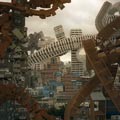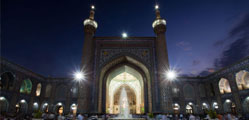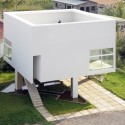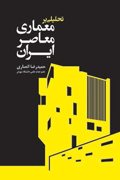چقدر یک معماری می تونه ساده شکل بگیره....
چند روز پیش داشتم به یکی از دوستان می گفتم، این که صفت سادگی در فرهنگ و هنر ایرانی و اسلامی مطرح شده خیلی جالبه و مهم. ما معمولا این صفت رو بد می فهمیم. مثلا فکر می کنیم سادگی یعنی پرهیز از تزئینات. یا مثلا می خوایم جلوی حذف تزئین رو بگیریم می گیم سادگی یعنی حذف بیهودگی ها و تزئین بیهود نیست...
خلاصه در جستجوی معنای سادگی مدام به کالبد و فرم نظر داریم، در حالی که من فکر می کنم این صفت رو به هیچ وجهی از وجوه نمی شه در فرم یا کالبد جستجو کرد.
سادگی ، به زعم من، یعنی ساده دیدن مساله و ساده برخورد کردن با اون به منظور پیدا کردن ساده ترین راه حل.....
وقتی حساب کنیم که در این دنیا چه میزان پاینده هستیم و چه قدر می ارزه گیر بدیم به این دنیا،
وقتی نگاه مون رو به افق بلند آفرینش بدوزیم
ناگهان سوداهای پیچیده انگار به تمامه در ذهنمون فرومیپاشه و سادگی متولد می شه.....
چند وقت پیش از بهترین رسولان خاطره ای رو می خوندم. او در برخورد با امری که مردم سخت می گرفتند راه حل اون رو، با انتخاب ساده ترین راهحل فرموده بودند، "امر از این ها ساده تره..." و این گزاره ساده، اساس تفکر سادگیه به زعم من.
امر از این ها ساده تره....

Location: Surendranagar district, Gujarat, India
Photographs: Courtesy of SABA and Alex Nosakov



 SABA, Spontaneous Architecture at the Bezalel Academy, was founded in 2005 by Sharon Rotbard. At SABA, 3rd year students invent experimental straying techniques, explore improvised construction materials, develop immediate technologies, build the first building in their career and spend there the last night of the semester. On September 2011, SABA moved for a summer semester in India. The program was held in collaboration with the Architecture Faculty at CEPT University Ahmedabad, the Chandigarh College of Architecture and The India Center for Environmental Education. The first part of the program was dedicated to a travelling workshop in Ahmedabad, Chandigarh and New Delhi, in which the studio investigated some of India’s architectures (modernist experiments, historical heritage, contemporary architecture), questioned its own practices and possibilities of travelling and movement (tourism, backpacking, architectural tourism, dérive), and researched and documented local samples of spontaneous architectures and unofficial technologies in cities, slums and villages. In the second part of the program SABA moved to the Center for Rural Knowledge near Halwad, a small town in Surendranagar district, Gujarat.
The Center for Rural Knowledge is located on the border of a semi-desert area, 15 km from the Little Ran of Kutch and 7km from Halwad, a small town (30,000 inhabitants) in Surendranagar district, Gujarat. It is a non-profit organization that had been founded by the Indian Center for Environmental Education, in the framework of various aid and self-aid actions initiated in the region after the 2001 earthquake. Since 2007, the center is located in a small farm with a small campus designed by the architect Neelkanth Chhaya, who designed few other CEE campuses in Gujarat.
The Center assures various types of activities. Its main task is aid for local farmers through study, research and development of new technologies of sustainable agriculture (soil improvement, irrigation, fertilization). The Center promotes various empowering activities among the region’s women, mainly through economical and accountability education, micro-banking and home and village industries. Since 2010 the center leads various educative activities for the region’s children, from babysitting for the young children to full-day seminars for school classes.
SABA, Spontaneous Architecture at the Bezalel Academy, was founded in 2005 by Sharon Rotbard. At SABA, 3rd year students invent experimental straying techniques, explore improvised construction materials, develop immediate technologies, build the first building in their career and spend there the last night of the semester. On September 2011, SABA moved for a summer semester in India. The program was held in collaboration with the Architecture Faculty at CEPT University Ahmedabad, the Chandigarh College of Architecture and The India Center for Environmental Education. The first part of the program was dedicated to a travelling workshop in Ahmedabad, Chandigarh and New Delhi, in which the studio investigated some of India’s architectures (modernist experiments, historical heritage, contemporary architecture), questioned its own practices and possibilities of travelling and movement (tourism, backpacking, architectural tourism, dérive), and researched and documented local samples of spontaneous architectures and unofficial technologies in cities, slums and villages. In the second part of the program SABA moved to the Center for Rural Knowledge near Halwad, a small town in Surendranagar district, Gujarat.
The Center for Rural Knowledge is located on the border of a semi-desert area, 15 km from the Little Ran of Kutch and 7km from Halwad, a small town (30,000 inhabitants) in Surendranagar district, Gujarat. It is a non-profit organization that had been founded by the Indian Center for Environmental Education, in the framework of various aid and self-aid actions initiated in the region after the 2001 earthquake. Since 2007, the center is located in a small farm with a small campus designed by the architect Neelkanth Chhaya, who designed few other CEE campuses in Gujarat.
The Center assures various types of activities. Its main task is aid for local farmers through study, research and development of new technologies of sustainable agriculture (soil improvement, irrigation, fertilization). The Center promotes various empowering activities among the region’s women, mainly through economical and accountability education, micro-banking and home and village industries. Since 2010 the center leads various educative activities for the region’s children, from babysitting for the young children to full-day seminars for school classes.SABA was asked to choose a location for a “children’s corner” within the farm’s compound, and to design and build 4 open classrooms of 15 m2. The basic program for each classroom was “one floor, one wall, one roof”. As the region is dry and annually, there are only 20 days of rain, it was left to the planners’ decision the choice between roofing and shading. Further specifications were suggested by the Center’s personnel and attached to the basic program – general activities, library, rest place, computer stand –. The general scheme defined one large common platform divided to 4 “parcels”. A set of few simple rules defined the building limits within each plot. According to the minimal Indian paradigm of “home” (“Home is where shoes are left outside”) the common area enabling free communication between the classrooms was declared “Barefoot Area”. The students formed 4 teams, each team was responsible for is own classroom; for the common area and tasks, the whole group worked conjointly. The design and building process was led in the spirit of Gandhi’s Village Swaraj doctrine – self work, local materials, and no machines. The design and building process, from arrival to inauguration, took 20 days. The students financed the materials and tools costs, about $300 per each classroom. Halwad project Faculty
The project faculty was composed by architects from Bezalel Academy and CEPT, as well as by retired local professionals (farmers, a mason, a carpenter, and a weaver).
Sharon Rotbard, Akbar Nazim Modan, Parth Shah, Ayub Sherasiya, Karshanbai, Sanjibai, and Gittabenn.
Participant
Jonathan Alon, Tamar Alon, Itai Bechor, Ayelet Ben David, Inbal Helzer, Alon Itzkin, Yael Johnson, Rajendra Menaria, Keren Christina Mendjul, Aleksei Noskov, Matan Pisante, Mevaseret Recanati, Michal Rosenfeld, Fouad Salem, Ronen Sarudi, Tali Serebro, Tal Tomer, Oded Wieder
















































